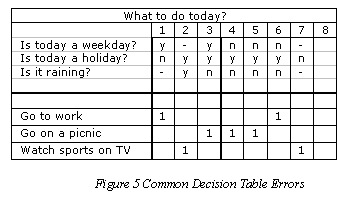
As discussed in the previous section, each rule in a decision table should be different. A decision table is referred to as mechanically perfect when all contradictions and redundancies are removed. In this section we'll review a few examples of common errors occurring in decision tables.
Table 1 itemizes the tools available in LogicGem to automatically uncover common decision table errors.
Incompleteness: Not all conditions are covered. Contradiction: Two rules with the same conditions lead to different actions. Redundancy: Two rules with the same conditions lead to the same action. Ambiguity: A reduced table with contradictory and/or redundancy errors.
The following shows a decision table exhibiting examples of redundant, contradictory and ambiguous rules:

Rule 4 and Rule 5 are redundant since the both contain the same conditions and action.
Rule 4 and Rule 5 are contradictory to Rule 6 since the same conditions map to different actions.
Rule 1 and Rule 7 are ambiguous since their conditions, when considering the "don't cares," overlap with different actions.